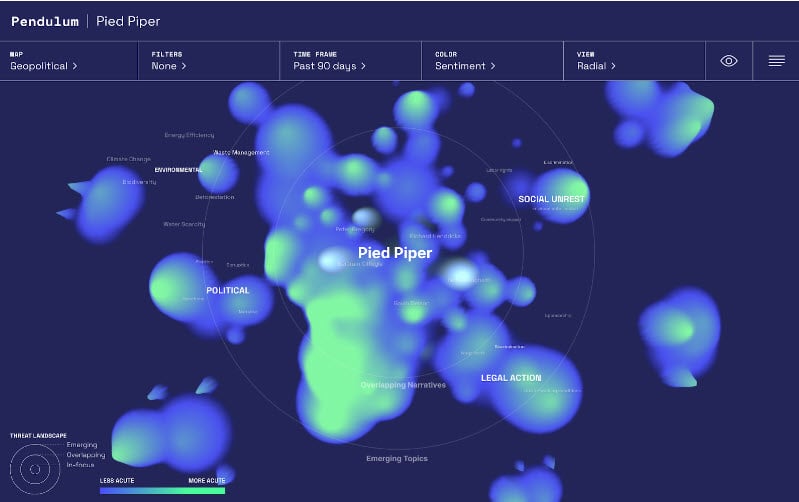Pendulum Launches ElectionIQ: Intelligence Into the 2024 U.S. Elections
ElectionIQ helps organizations navigate the 2024 US elections by providing proactive insights to identify risks, trends, and narratives that directly...
3 min read
Pendulum : September 05, 2023

Strategic Intelligence has always been about keeping a step ahead, but the game is changing with the advent of Large Language Models (LLMs) and Generative AI. These innovations are supplemental tools and catalysts that redefine how we approach risk resilience, threat analysis, and business strategy. In an environment where risks can range from disease outbreaks, economic crises, cyber-attacks, supply chain disruptions, and regulatory changes to environmental disasters, the agility and depth provided by these technologies are crucial.
LLMs and Generative AI tools have tremendous potential. Where Strategic Intelligence is the primary function, these tools assist analysts throughout crucial phases of their intelligence lifecycle, including:
Threat definition tools must go beyond conventional risk alerts and Boolean keyword searches to help analysts isolate threats proactively, buying businesses precious time to address looming challenges. LLMs and Generative AI tools give analysts such capabilities as:
Consider topics like ESG (Environmental, Social, and Governance) concerns. Traditional tools might offer generic alerts on ESG regulations, but LLMs can parse out nuanced narratives – say, the implications of a new carbon-neutral policy for a specific industry.
The goal is not just to gather data but to make it actionable. Intelligent narratives isolate threats that matter to a particular business, thus reducing the noise-to-signal ratio. This laser-focused approach ensures that the intelligence gathered is not just voluminous but valuable, leading to informed decisions and effective risk management. For example, when faced with geopolitical tensions in a region, an analyst could use these tools to rapidly understand the historical context, identify key players, and predict potential business ramifications, thereby formulating informed strategies.
Producing great analysis is predicated upon asking great questions and formulating hypotheses and threads to follow. One of the most challenging aspects of the private sector job of threat intelligence is the daunting size of surface area and varying subject matter. The promise of LLMs and generative AI can help analysts codify and understand new domains and get critical insights quicker.
Traditionally, venturing into unknown topics meant a steep learning curve. LLMs and the vast context they encode change by facilitating rapid immersion, helping analysts discern critical aspects without delay. It's not just about accessing information; it's about understanding what's important and why, leading to quicker, more insightful analysis. LLMs can help analysts quickly craft a set of hypotheses, scenarios, and steps to execute.
Once plans are crafted, Generative AI helps analysts turn their scenarios into a group of narratives that can define the topics with the right level of precision and context. Gone are the days of iterative Boolean definitions and figuring out which words to use. You can spend more time understanding top-level trends, tracking narrative development over time, and observing the most critical details.
In the ever-evolving landscape of security threats, the ability to detect subtle and complex indicators is paramount, and this is where advanced threat detection goes beyond traditional sentiment analysis to provide a deeper, more nuanced understanding of potential risks.
In the age of information deluge, basic sentiment analysis often falls short. What’s needed is a deeper dive into the nuances beyond simple positive and negative mentions. For example, many antisemitic or conspiracy references will likely be picked up as neutral sentiment and thus never discovered in the sea of content. Higher fidelity and dimensionality of sentiment detection are needed to help analysts ensure they are not missing anything important.
Analysts often find themselves inundated with data. Generative AI tools like summarization and topic extraction alleviate this burden by allowing for efficient pattern recognition. These tools don't just condense information; they transform it into insights, enabling analysts to see the bigger picture without getting lost in the details. For example, summarization and entity extraction allow analysts to identify which competitors or other relevant companies the specific context they analyze mentions, enabling them to make better action recommendations.
In the process of Strategic Intelligence, report writing stands as a bridge between raw data and actionable insights, and the integration of Large Language Models and Generative AI is revolutionizing this process by combining human expression with automation.
Report writing is an art and a science. The flexibility to express any topic and ensure comprehensive analysis allows analysts to harness their expertise in new and powerful ways. It's about blending human insight with technological efficiency to create reports that are not just informative but insightful.
Automation in report production doesn't mean a loss of control; it's a gain in efficiency. Generative AI automates the process while retaining human oversight in verifying, editing, and publishing. It's a balance that ensures quality, saves time, and allows analysts to focus on what they do best: analyze and advise.
LLMs and Generative AI are not mere additions to the analyst's toolkit but transformative forces. From nuanced threat definition to revolutionary report writing, these tools empower analysts to operate at new levels of effectiveness. In an ever-changing global landscape filled with uncertainties, innovation is not just a luxury; it's a necessity for any forward-thinking analyst.
Strategic Intelligence presents a transformative leap, revolutionizing our understanding, approach, and response to potential risks. The benefits of harnessing LLMs and Generative AI are game-changing. If you're eager to navigate the complexities of tomorrow with unmatched precision and insight, reach out for a demo and see how our cutting-edge technology can make a tangible difference.

ElectionIQ helps organizations navigate the 2024 US elections by providing proactive insights to identify risks, trends, and narratives that directly...

At Pendulum, we're not just redefining the landscape of threat and risk intelligence; we’re empowering organizations to convert risks into...

In the world of business risks, where Strategic Intelligence has taken center stage, risk analysts are the critical navigators in this complex...